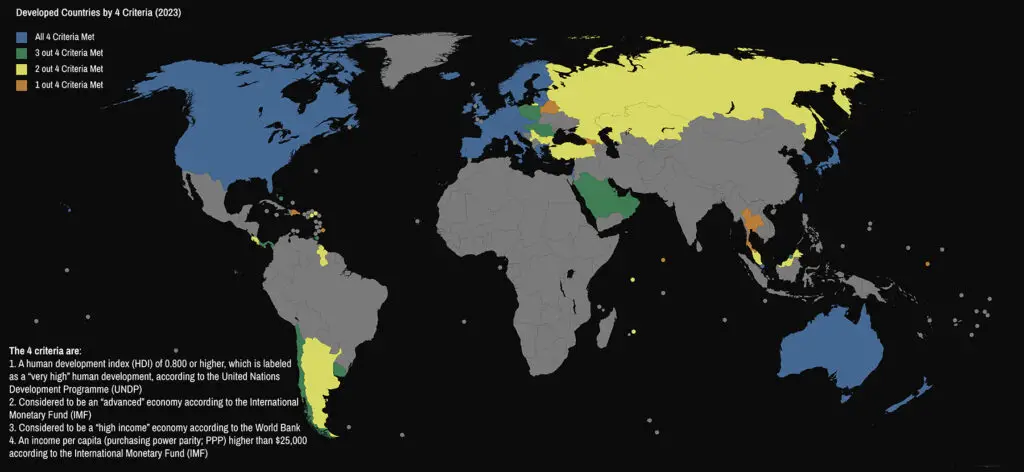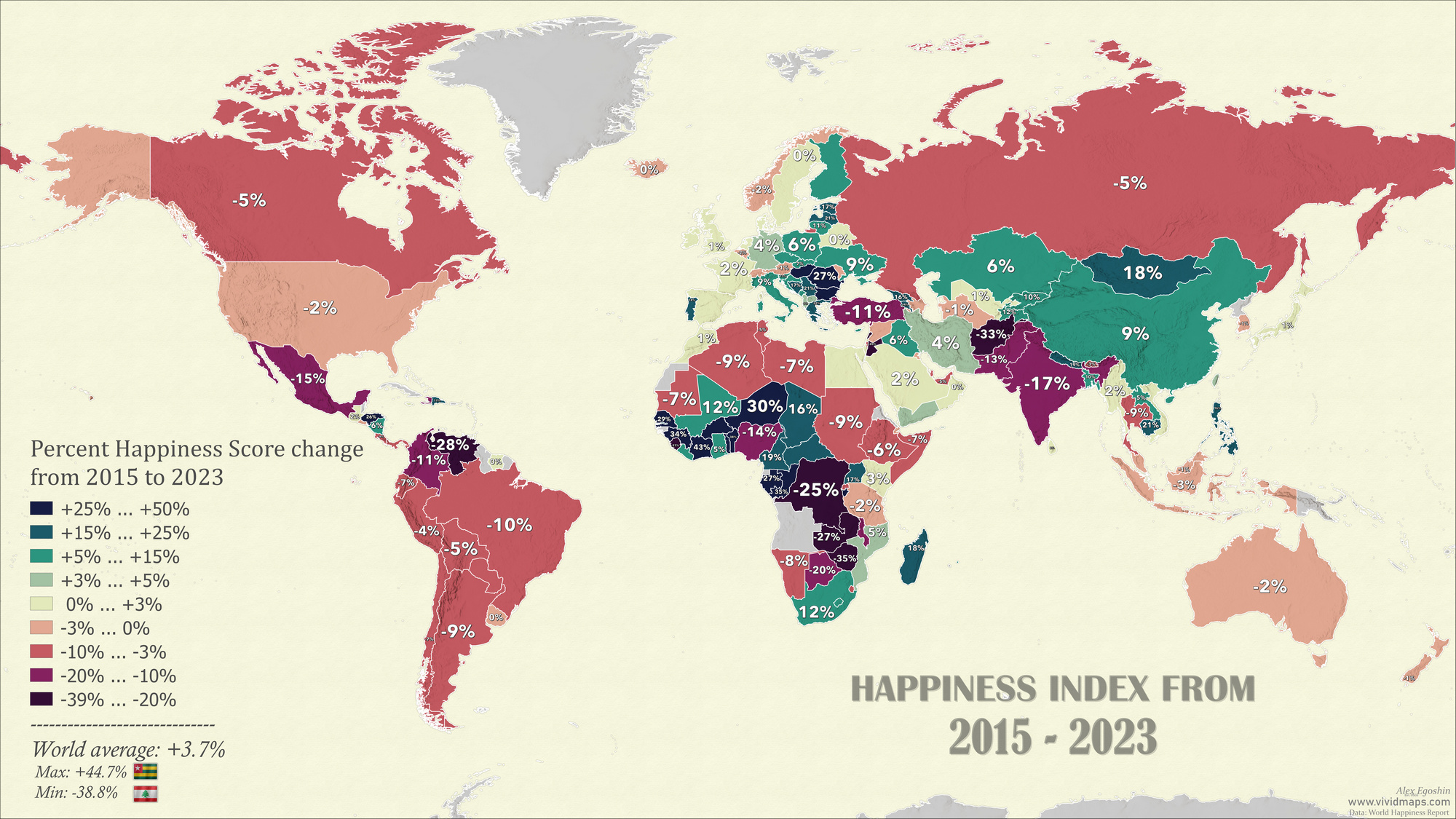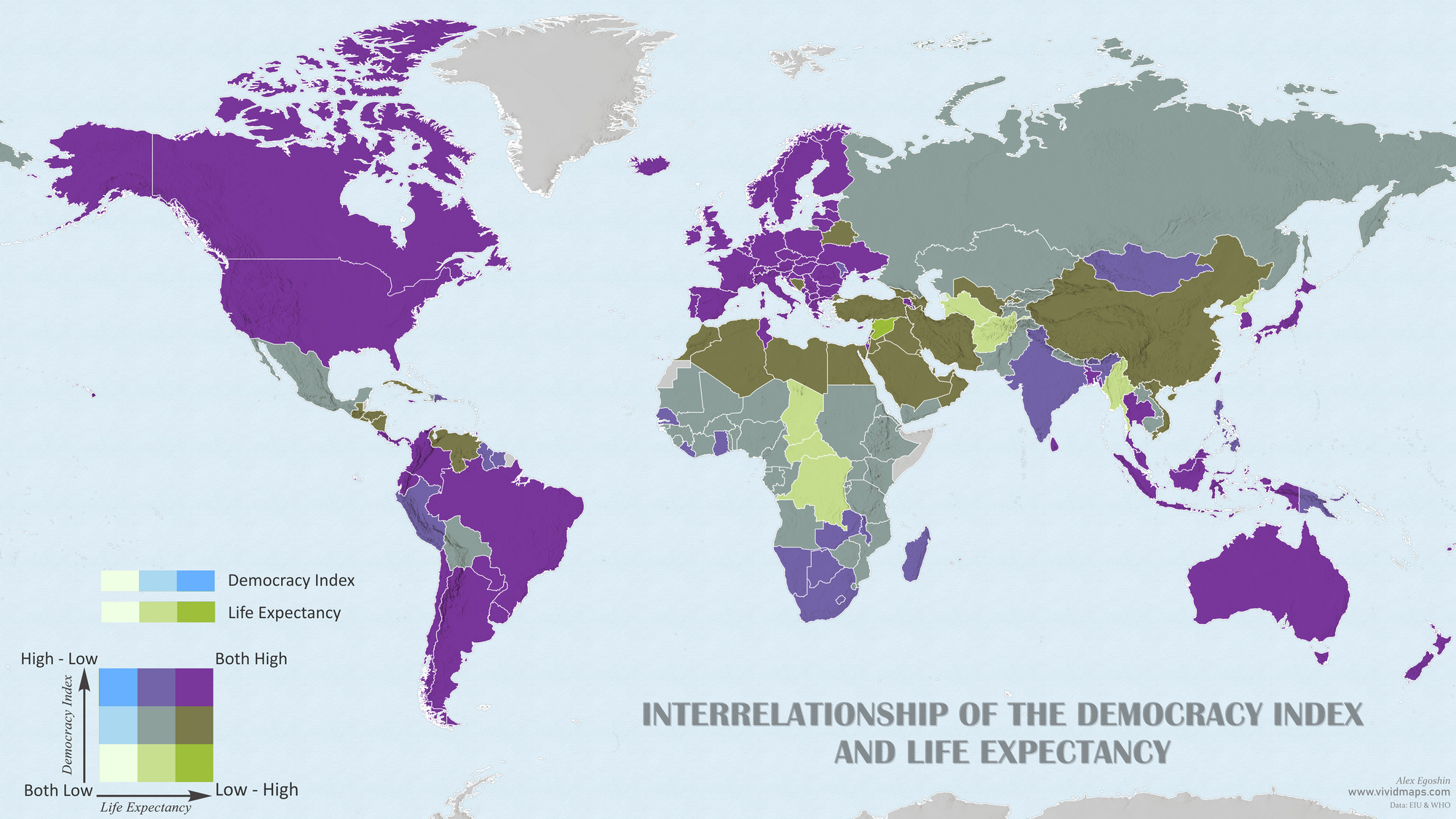Exploring the Metrics: How Do We Define Developed Nations?
The classification of countries as “developed” is a complex and evolving concept, often subject to interpretation and debate within the field of economics and international relations. While there isn’t a universally agreed-upon set of criteria, several indicators are commonly considered when assessing a country’s level of development. These criteria encompass economic, social, and infrastructural dimensions.
The world map below illustrates countries that can be classified as developed according to four different criteria:
The Human Development Index (HDI), created by the United Nations Development Programme (UNDP), is a composite measure assessing a country’s development based on three core dimensions: health (life expectancy at birth), education (mean and expected years of schooling), and standard of living (Gross National Income per capita adjusted for purchasing power parity). By providing a multidimensional view, the HDI offers a more comprehensive understanding of a nation’s well-being, beyond economic indicators alone.
Countries with very high human development typically have HDI values above 0.8, indicating a high standard of living, long life expectancy, and advanced education systems.
HDI values above 0.8 have the following countries: Switzerland, Norway, Iceland, Hong Kong, Australia, Denmark, Sweden Ireland, Germany, Netherlands, Finland, Singapore, New Zealand, Belgium, Canada, Liechtenstein, Luxembourg, United Kingdom, South Korea, Japan, United States, Israel, Slovenia, Malta, Austria, United Arab Emirates, Spain, France, Cyprus, Italy, Estonia, Czechia, Greece, Poland, Saudi Arabia, Lithuania, Bahrain, Portugal, Latvia, Croatia, Andorra, Qatar, Chile, San Marino, Slovakia, Hungary, Argentina, Turkey, Montenegro, Kuwait, Brunei, Russia, Romania, Oman, Bahamas, Kazakhstan, Trinidad and Tobago, Uruguay, Costa Rica, Belarus, Panama, Malaysia, Serbia, Mauritius, Georgia, Thailand.
The International Monetary Fund (IMF) classifies economies based on their Gross National Income (GNI) per capita.
According to the IMF, advanced economies are typically characterized by high levels of industrialization, technological advancement, and well-established financial systems.
The International Monetary Fund considers the following countries as advanced economies: Austria, Belgium, Canada, Croatia, Cyprus, Czech Republic, Denmark, Estonia, Finland, France, Germany, Greece, Hong Kong SAR, Iceland, Ireland, Israel, Italy, Japan, Korea, Latvia, Lithuania, Luxembourg, Macao SAR, Malta, The Netherlands, New Zealand, Norway, Portugal, Puerto Rico, San Marino, Singapore, Slovak Republic, Slovenia, Spain, Sweden, Switzerland, Taiwan Province of China, United Kingdom, United States.
The World Bank also classifies economies into income groups based on their Gross National Income (GNI) per capita.
Economies with a GNI per capita of $13,845 or more are considered high-income economies.
In terms of this criteria, high-income economies include Andorra, Antigua and Barbuda, Australia, Austria, The Bahamas, Bahrain, Barbados, Belgium, Brunei, Canada, Chile, Croatia, Cyprus, Czech Republic, Denmark, Estonia, Finland, France, Germany, Greece, Guyana, Hungary, Iceland, Ireland, Israel, Italy, Japan, South Korea, Kuwait, Latvia, Liechtenstein, Lithuania, Luxembourg, Malta, Monaco, Nauru, Netherlands, New Zealand, Norway, Oman, Panama, Poland, Portugal, Qatar, Romania, Saint Kitts and Nevis, San Marino, Saudi Arabia, Seychelles, Singapore, Slovakia, Slovenia, Spain, Sweden, Switzerland, Trinidad and Tobago, United Arab Emirates, United Kingdom, United States, Uruguay, American Samoa, Aruba, Bermuda, British Virgin Islands, Cayman Islands, Guernsey, Curaçao, Faroe Islands, French Polynesia, Gibraltar, Greenland, Guam, Hong Kong, Isle of Man, Macao, New Caledonia, Northern Mariana Islands, Puerto Rico, Saint Martin, Sint Maarten, Taiwan, Turks and Caicos Islands,U.S. Virgin Islands.
In addition, the International Monetary Fund (IMF) classifies economies based on their income per capita when adjusted for purchasing power parity (PPP).
According to the IMF, high-income countries have a GNI per capita above $25,000 when adjusted for PPP. This classification reflects a higher standard of living, higher economic development, and increased purchasing power in these nations.
By these criteria, relatively advanced and prosperous economies are Croatia, San Marino, Andorra, Latvia, Lithuania, Greece, Estonia, Slovakia, Czech Republic, Malta, Liechtenstein, Monaco, Slovenia, Portugal, Israel, South Korea, New Zealand, Cyprus, Taiwan, Spain, Singapore, Finland, United Kingdom, Ireland, Iceland, Sweden, France, Australia, Belgium, Canada, Italy, Austria, Germany, Japan, Netherlands, Denmark, Luxembourg, United States, Norway, Switzerland, Uruguay, Chile, Trinidad and Tobago, Romania, Panama, Bahamas, Hungary, Poland, Kuwait, Bahrain, Oman, Saudi Arabia, United Arab Emirates, Brunei, Qatar, Serbia, Costa Rica, Mauritius, Argentina, Montenegro, Bulgaria, Kazakhstan, Malaysia, Saint Kitts and Nevis, Russia, Seychelles, Turkey, Dominican Republic,
Guyana, Maldives, Antigua and Barbuda.

Based on the fulfillment of all four criteria, 40 nations are classified as developed countries, with the majority being members of the European Union. Apart from the EU member states, other nations such as the UK, Canada, the USA, Israel, South Korea, Australia, New Zealand, Cyprus, Taiwan, Singapore, and Japan are also recognized as developed nations, meeting all specified criteria.
Nations deemed economically developed based on three criteria (excluding gross national income per capita as measured by the International Monetary Fund) include Uruguay, Chile, Trinidad and Tobago, Romania, Panama, Bahamas, Hungary, Poland, Kuwait, Bahrain, Oman, Saudi Arabia, United Arab Emirates, Brunei, and Qatar.
Based on two criteria, the nations classified as economically developed include Serbia, Costa Rica, Mauritius, Argentina, Montenegro, Bulgaria, Kazakhstan, Malaysia, Saint Kitts and Nevis, Russia, Seychelles, Turkey, Guyana, and Antigua and Barbuda.
Based on a single criterion, only seven countries meet the classification as developed nations: Barbados, Dominican Republic, Thailand, Maldives, Georgia, Nauru, and Belarus.








